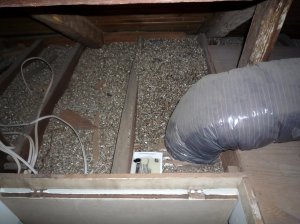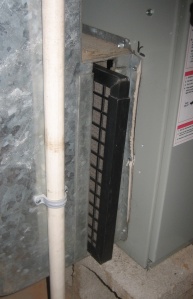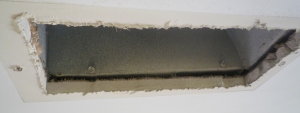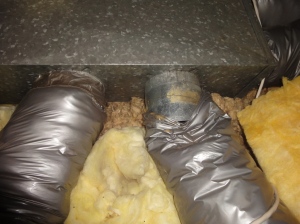Do you feel like your house is always dusty, in spite of how much you vacuum and clean? Have you tried all the tricks – HEPA vacuum cleaners, air cleaners, taking your shoes off before coming in the house, washing the dog…. all to no avail?
Chances are good that you’re being plagued by a leaky duct and air handling system.
When you have leaks in your ducts (virtually all duct are leaky) dust from the attic gets sucked into the ducts and distributed throughout the house. Even if you have an excellent filtration system on your air handler, the dust can be sucked in from places that don’t get filtered, and blown into your home, usually leaving fine gray dust everywhere.
Before you call in a heating/cooling (HVAC) contractor, there are a few steps that you can take yourself.
Warning: working in an attic can be dangerous. Many attics don’t have proper floors. Numerous people have taken bad steps and fallen through the ceiling, often resulting in serious injury or death.
Assuming you are comfortable working in the attic and can safely access the duct work and air handling system, here are some things to check:
- Ensure that the air filter port is sealed air-tight.
At least 10% of the systems I see look like the one in this picture. The air filter port is open and an over-sized filter is sticking out the side. Not only does this rob you of 20%-50% of your system’s efficiency(!) and cause the air to get extremely dry in the winter, but it sucks nasty, dusty attic air into the system where it is blown throughout the house. Fix this simple problem (get the right sized filter and tape over the port) and you will see immediate energy savings and probably a much less dusty home. -
Check your air registers around your house
Your home’s air registers should mostly be clean. If some are much dustier than others, this is a sign of leaks near that particular register. Sometimes it will be a leaky duct leading to it, other times it may be the register itself is poorly attached to the ceiling, providing a gap right into the attic. I’m always suspicious when I see a really dusty register. - On a cold and windy day, turn off your forced air system (air conditioner, heat pump or furnace) and see if you can feel a cold breeze coming from any of the air registers in the house. The duct system is supposed to be completely sealed, so you should never feel really cold air blowing in. You might feel cool air drifting in due to the ducts being cold, which causes the cool air to “drop” out of the ducts. But if you can correlate cold air blowing in with wind outside, you’re sure to have leaks. The more of a breeze you feel, the closer you are to the leak.
-
Look around the attic to see if any ducts are visibly detached or “askew”, particularly at registers and ducts that failed test #3 above.
These can be hard to find, but sometimes it’s pretty obvious. All the ducts should be nearly and strongly attached at both ends – where it leaves the main trunk lines and where it feeds the ceiling registers or air returns.
I’ve seen cases where the ducts have totally fallen off and are just lying on in the insulation.
Note: special tools and adhesives are used to connect ducts in a permanent fashion. Do not attempt to repair these problems with “duct tape”! – this tape will fail and you’ll be left with leaky ducts again. Instead, industrial strength zip-ties and tensioning tools are used along with a sealant called “mastic.” - Sometimes problems are hidden in walls
You might not be able to find any problems in the attic but the problem could still lie in your ducts. Many duct systems run through walls and hidden cavities in your home. It is even common practice to use naked wall cavities without ducts! Contractors will just pick a wall, ceiling or floor cavity and run air through it. This horrible practice really shouldn’t be permitted because it causes so many problems.
This type of problem you probably can’t find yourself. A trained infrared thermographer (often an energy auditor or building scientist) may be able to locate the problem, but sometimes it can be very difficult.  Beware of Vermiculite
Beware of Vermiculite
Some older homes have Vermiculite insulation in the attic. These homes should not be tested using a blower door or duct blaster and you should not poke around in this material because it may contain asbestos. Not all Vermiculite contains asbestos, but this is definitely a case of “better safe than sorry.”
I started this post saying that you shouldn’t call in your HVAC contractor and I’ll finish it by saying the same thing. Many HVAC contractors are not trained to find these leaks. Think about it – who created these leaky ducts in the first place?
As a building science / energy consultant, I’m biased because I’m an independent consultant, and I recommend that you use someone who is also independent to diagnose your issues. They might fix them as well or they recommend a high-quality HVAC contractor whom they know to do good work. They will also have special equipment like a “blower door” and a “duct blaster” that allows them to quantify the leakiness of your ducts much more quickly and accurately than someone without these tools. In fact, without at least a blower door, it will be very difficult to even find many duct leaks.
Fixing duct leaks can help make your house much less dusty and it has the side effect of making it more comfortable and energy efficient. This is one of those things that you’ll wish you had done years ago because it can make your house more enjoyable to live in every day of the year.
Follow-ups:
“Why does house get dusty when heat on and not with ac on?”
Occasionally, weird things happen. If you’ve gotten this far, you know that the dust is usually sucked in and distributed by the duct system. If that’s so, then how does the above situation occur?
There one possibility that comes to mind – moisture.
During the summer, the cold coils in the air conditioner are covered with water – this is the summer moisture getting drawn out of the air. When the dusty air moves through the coils, much of this dust could be trapped by that water. This would lead to much less dust when the air conditioner runs than when the heat is on.
“Does an energy audit show why there is so much dust in the house?”
Someone else asked this question. The answer is “maybe.”
If the energy audit is a comprehensive review of your home, done by a competent technician, then yes, the audit should be able to show why your home is dusty. To make sure, you should tell your auditor that you’re having a dust problem and you’d like some help finding out why. If they look confused and don’t suggest issues like the ones mentioned in this post, you should probably find a different auditor!
“Why is the air so dry in the winter?”
What does dry air have to do with a dusty house? Possibly everything!
If your duct system is sucking dusty air in from the attic, it will also suck in the very cold, dry air from the attic. When that dry air enters your house, it sucks up the moisture from your home like sponge, resulting in very dry air. That’s why an uncomfortably dry home in winter is a giveaway that the home is very leaky.
Keep in mind that the dry outside air could be coming from anywhere. If you have leaky windows and doors and a drafty house, it’s also going to be uncomfortably dry. That said, nothing dries out a house faster in winter than a leaky duct system that’s sucking in cold, dry outdoor air.




Hi. my name is Eric from Riverside, California, ‘was researching to get answers and solve the persistent dust accumulation inside my 2 storey 2013 house for years now. I am the second owner of this house in 2016, hired electrician installed recessed lights and ceiling fans in all the rooms before living in it. Everyday I sweep the floors and rooms of the whole house, and there’s a lot of this whitish, linty dust material. Even if I dont use the HVAC, there is still lots of dust in the entire house. I have an HVAC in my attic. no crawl space on the 1st floor ceiling. I have fiberglass insulation in the attic. I have hvac annual membership, who did multiple times visually checked the hvac system in the attic and was told ” no problem with the HVAC and ducts’ in the attic. I also have 5 attic insulation company checked visually my attic, and was told that they don’t think the dust is coming there. Both advised on getting air scrubber which MIGHT solve the problem. I even placed fine netted mesh cloth material on all the ceiling vent 2 months ago, but I don’t see any trapped dust particles. The house windows and doors are properly sealed. Kindly advice on what I need to do. I have tried but COULD NOT find company that do Blow Door Test with infrared scan to diagnose possible leaks inside the house. Who do I call to properly diagnose and solve the problem? Do you have any trusted affiliated company in Southern California that can help me fix this dust problem. Thank you.
Hi Eric,
First off – an air scrubber is a band aid solution. The important thing is to get to the root cause of the excessive dust. It’s like the proverbial “bailing out the boat and ignoring the leak.”
My first suggestion is to check your laundry dryer duct connection. I was just in a house and happened to look behind the dryer and saw the duct had fallen off. Voila – 15-minutes later, the vent was back on and the hose clamp was properly tightened.
It can be difficult to find people to do this kind of work. I had to search a bit with different “trade” terms before I came up with some in your area. Here’s some possibilities. Note that these are just people I found through Google searches. I don’t personally have any experience with them.
https://www.ecohers.com/
https://www.plusair.net/
https://www.rescal4u.com/
https://www.rkmair.com/home-performance/energy-audits – this is an HVAC company. I usually recommend an independent organization as one can never tell if a company selling equipment will give an objective evaluation. However, you never know and it might be worth a call.
http://www.jonesenergyinfo.com/ – might be too far away
Let them know that you’ve got a mysterious dust/lint problem and nobody has been able to figure it out so you want to get a blower door test and IR scan, if they have the equipment, to see if there’s significant infiltration that could be leading to the problem.
So I too have been battling this same situation. Started in May 2022 (Houston Tx) and by December I had to stay in a hotel room. Replaced both HVAC / Ducts / Blown in insulation in January of this year and it seemed to have made the problem worse. I’m 99% sure that my dust is fiberglass particles breaking off the original 22 year old Batt insulation surrounding the upstairs game room. Before May 2022, no dust, by July I started this 8 month journey of declining health and sanity. For it to just happen like this, something must have happened but I’m lost. Almost suspicious of a strong wind event or concrete foundation problem that caused the geometry of the house frame to shift causing a negative pressure inside the conditioned space. Hopefully you found your solution.